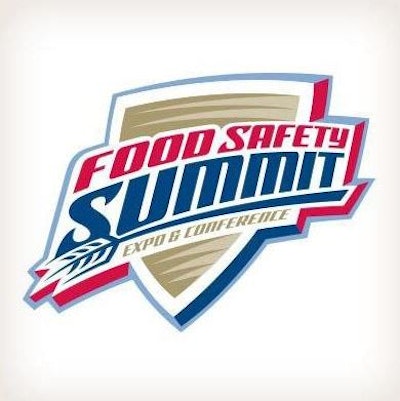
As the first day of the 2015 Food Safety Summit comes to a close, I’d like to share my experiences thus far in case any of our readers were unable to make the trek to Baltimore to attend this year’s event.
More than 1,500 industry professionals – including processors, retailers, distributors, foodservice operators, regulators and academia -- are convening this week at the Baltimore Convention Center in Maryland to discuss and gain insight on food safety best practices.
Today’s main event, the Integrating the Nation’s Food Safety Forum, looked at what an Integrated Food Safety System (IFSS) truly is and why it is needed, as well as ways to best implement the integration.
What is IFSS?
In summary, an integrated food safety system is when public health and regulatory partners work collaboratively across all jurisdictions – local, state and federal.
This vision can be achieved by having a set of consistent national standards to ensure a highly-skilled workforce throughout all jurisdictions and levels of government.
While integration has been talked about for many years, it was former president Bill Clinton’s food safety initiative in the late ‘90s that really pushed the initiative forward.
Joseph Corby, executive director of AFDO, opened the presentation with explaining why integration throughout the food industry is needed.
“Those of us in the food safety regulatory groups know that we’re stronger and better by working together,” Corby said. “The food system is too dispersed and there’s just too much to do alone.”
Corby said this partnership is an obvious solution to creating a safe food supply, but it’s not necessarily a new concept.
“This is how we will meet consumer expectations; by providing oversight of the food industry,” Corby added.
The Past
So why weren’t things working well before?
In recent years, the food system was full of high-profile outbreaks (E.coli in spinach in 2006, botulism in chili sauce in 2007). Thankfully, the White House and Congress supported the idea of change.
The past contained food regulatory response silos that offered little consistency in response coordination between local, state and federal governments. And to make matters worse, there was very little funding available to support the response integration.
But the 1998 meeting in Kansas City was a milestone for pushing the integration initiative, Corby said.
Some problems and concerns at that time, included:
- Non-uniform national standards.
- Non-uniform laboratory practices.
- Non-uniform inspections among FDA districts, 75 state agencies and 3,000 local agencies.
- Non-coordinated surveillance.
- Lack of training/training plan.
- Slow communication efforts.
In short, there was a lot of room for improvement in 1998. So in response to the food safety initiative meeting, federal, state, territorial, tribal and local agencies began working together at a national level to address pieces of an integrated safety system.
While there was some successes at that time, efforts were not sustained and the abilities to keep moving the initiative forward had failed.
What Now?
Currently, there has been an uptick in the development of Rapid Response Teams (RRT) to help capture best practices and share them with others. The RRT program is helping to improve integrated response by avoiding duplications and synergizing resources.
The rapid identification and control of contamination sources allows the RRT to restore consumer confidence, mitigate regulatory economic impacts and restore the COO within the affected food firms.
There are currently 40 programs in 39 states that are actively working toward total conformance of standards. States not enrolled are those with small populations or those that do not have many manufactured foods.
Wisconsin is the first and only state to become fully-compliant. The others are working to quickly conform.
The Future and the New Vision
Mutual reliance in cooperation and collaboration is key. Together, Corby said, we can go much further. While the AFDO and FDA do not have all the answers, they are continuing to measure progress and identify what the key points are to continue onto an IFSS.
To successfully implement an IFSS, the foundational elements would need to include:
- Joint work planning, including risk ranking and inventory sharing.
- Sharing of inspection results and joint inspections where appropriate.
- Joint enforcement and compliance teams.
- Coordinated, practiced responses to significant events
- Joint after-action reviews of significant events
- Immediate notification of egregious events.
Pat Kennelly of the California Department of Health said although food safety has always been of importance, the culture has changed tremendously over the years.
“No one agency can protect our nation’s food supply alone,” Kennelly said. “Unification of public health is the strength that drives us together to solve these issues.”
The Deputy Associate Commissioner for Regulatory Affairs at the FDA, Steve Solomon, made it clear that the integration of the food safety system will take time and continuous improvement.
“There’s not going to be a magical moment where we say ‘Eureka! We have an IFSS!’ It’s going to evolve with time, trials and errors.”






















